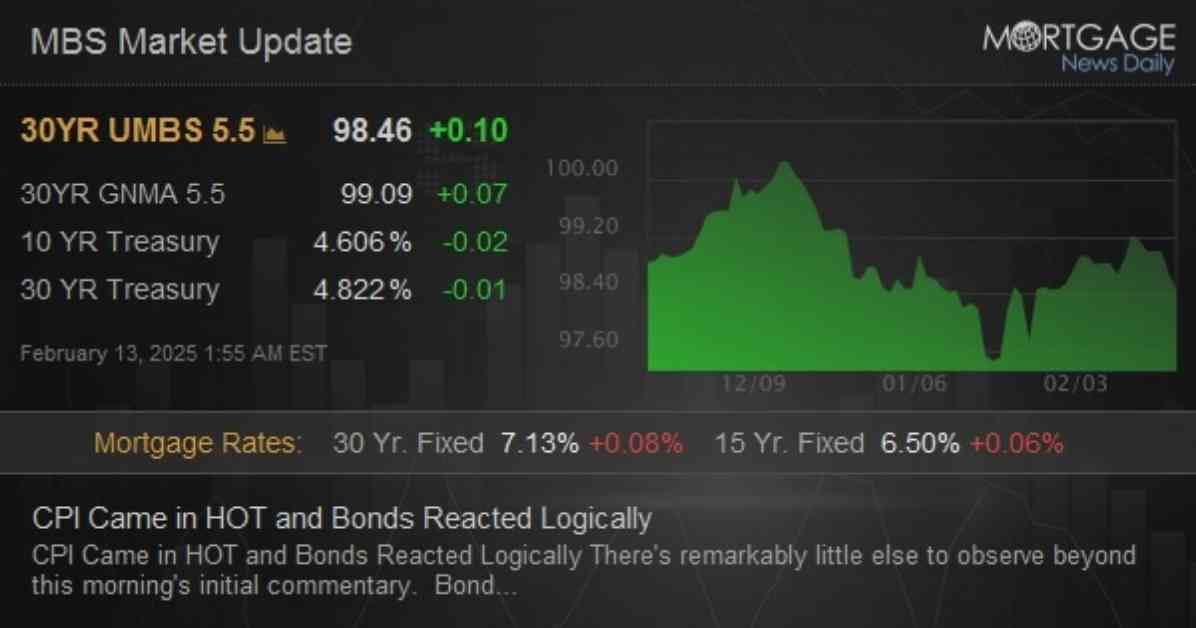On a chilly Wednesday morning, the financial world was abuzz with the latest Consumer Price Index (CPI) data release. The numbers were in, and they were hot – hotter than anyone had expected. As seasoned investors and analysts tuned in to the market’s reaction, the bond market took center stage, showcasing a logical response to the unexpected surge in inflation.
The impact was immediate and significant. 10-year Treasury yields shot up by approximately 10 basis points, while Mortgage-Backed Securities (MBS) saw a decline of 3/8ths of a point. It was a moment of truth for bond traders, who were closely monitoring the situation for any signs of panic or uncertainty. But amidst the chaos, there was a sense of predictability in the air – bonds were simply doing what they were supposed to in the face of such a pronounced inflationary spike.
As the day unfolded, the bond market continued to reflect the CPI’s influence with remarkable precision. Despite the initial flurry of activity in the first two hours of trading, bonds managed to hold their ground, avoiding any further onslaught of selling pressure. By the time the dust settled, yields had stabilized, aligning closely with the levels observed mere minutes after the CPI data was made public.
Expert Insights on Core CPI Data
Taking a closer look at the core CPI figures revealed some intriguing details. The monthly core CPI came in at 0.4, surpassing the market’s expectations of 0.3 and marking a significant uptick from the previous reading of 0.2. Delving deeper into the unrounded data, the core monthly CPI stood at 0.446, painting a clearer picture of the inflationary pressures at play.
On an annual basis, the core CPI exhibited a similar trend, clocking in at 3.3 compared to the forecasted 3.1 and the previous figure of 3.2. These numbers underscored the persistent rise in consumer prices, fueling concerns about the broader economic landscape and the Federal Reserve’s policy decisions in the months ahead.
Market Reactions and Resilience
Amidst the turmoil unleashed by the CPI data, the bond market experienced a rollercoaster ride of fluctuations. In the early hours post-announcement, MBS faced a steep decline of nearly half a point, while the 10-year Treasury yield surged by 11 basis points, reaching 4.639 in a matter of minutes. The abrupt movement left investors grappling with the sudden shift in market dynamics, prompting a flurry of recalibrations and risk assessments.
However, as the day progressed, a sense of equilibrium began to emerge. A modest recovery was witnessed leading up to the 10-year auction, offering a glimmer of hope to market participants. Yet, this respite was short-lived, as subsequent events saw a reversal of fortune, with the 10-year yield climbing to 4.638 and MBS experiencing a decline of over 3/8ths.
Despite the initial turbulence, the bond market managed to find its footing, displaying a degree of resilience in the face of adversity. As the trading day drew to a close, the 10-year yield stood at 4.635, up by 10.7 basis points, while MBS saw a comparable dip of just over 3/8ths. This semblance of stability amidst the chaos underscored the market’s ability to navigate choppy waters with a degree of composure and poise.
In conclusion, the impact of the CPI data on the bond market was profound and far-reaching, underscoring the intricate interplay between economic indicators and market dynamics. As investors and analysts dissected the day’s events, one thing became abundantly clear – in the world of finance, volatility is often the norm, and adaptability is the key to survival. The bond market’s reaction to the CPI data served as a poignant reminder of the ever-evolving nature of global markets, where every data point has the power to shape the course of financial history.














